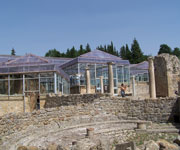Villa del Casale at Piazza Armerina is the supreme example of a luxury Roman villa, graphically illustrating the predominant social and economic structure of its age. Its decorative mosaics are exceptional for their artistic quality and invention as well as their extent.An earlier rural settlement generally thought to have been a farm, although on slender evidence, existed on the site where the late Roman villa was built. Its orientation was the same as that of the baths of the villa, and its foundations were discovered beneath parts of the villa.

Continent: Europe
Country: Italy
Category: Cultural
Criterion: (I) (II) (III)
Date of Inscription: 1997
Residence of a rich tenant
The existence of baths in the earliest phase of the site suggests that it was the residence of a rich tenant or the steward of a rich landowner. Two portraits were discovered dating from the Flavian period (late 1st century AD) that may represent members of the owner's family. The stratigraphy of this earlier house provides a chronology from the 1st century AD to the Tetrarchy at the end of the 3rd century.
 |
| Villa Romana del Casale Italy |









No comments:
Post a Comment